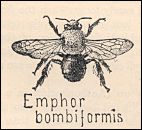
When someone mentions "bees", people usually think of the introduced honey bee, or possibly bumble bees. These are examples taken from a large number of social-bee species. But there is also a large number of solitary bees—bees that do not live in hives or colonies. Both groups are well represented in the Chihuahuan Desert.
Recent work has turned up some interesting behavioral similarities and differences. At least some species within both groups "mark" flowers with chemicals, sending a message to themselves and other bees about the individual flower. Among some bumble bees, for example, it appears that especially productive flowers are marked so that any member of the colony can revisit it and expect to be well rewarded.
Things seem more complicated among the solitaries, which use two types
of markings. One is a short-lived signal telling the original bee to return to that
flower and finish gathering the nectar. The other says "This flower is
mine—stay away." This works for the most part, but a few dominant
individuals simply override such signals and make their mark over the original.

Contributor: Arthur H. Harris, Laboratory for Environmental Biology, Centennial Museum, University of Texas at El Paso.
Desert Diary is a joint production of the Centennial Museum and KTEP National Public Radio at the University of Texas at El Paso.

A native bee. After Lutz (1921).
Frankie, G. W., and S. B. Vinson. 1977. Scent marking of passion flowers in Texas by females of Xylocopa virginica texana (Hymenoptera: Xylocopidae). Journal of the Kansas Entomological Society, 50:613-625.
Stout, J. C, D. Goulson, and J. A. Allen. 1998. Repellent scent-marking of flowers by a guild of foraging bumblebees (Bombus spp.). Behavioral Ecology and Sociobiology, 43:317-326.
Goulson, D., S. A. Hawson, and J. C. Stout. 1998. Foraging bumblebees avoid flowers already visited by conspecifics or by other bumblebee species. Animal Behaviour, 55:199-206.